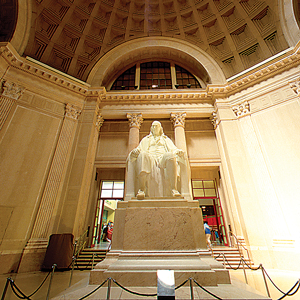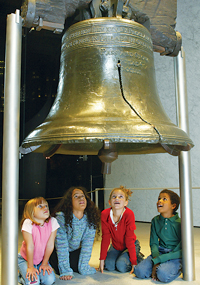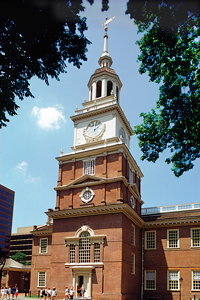 Presidents’ Day is this month. By now, we all know that young George didn’t throw a dollar across the Potomac River – and that he didn’t chop down a cherry tree, which means he couldn’t have come clean about it to his father – demonstrating his moral fiber to all posterity. Legends like these typify the tales often unearthed in travels through history.
Presidents’ Day is this month. By now, we all know that young George didn’t throw a dollar across the Potomac River – and that he didn’t chop down a cherry tree, which means he couldn’t have come clean about it to his father – demonstrating his moral fiber to all posterity. Legends like these typify the tales often unearthed in travels through history.
On our family’s recent trip to Philadelphia, a four-and-a-half-hour drive from Richmond, we made discoveries that shed light on information about Washington as well as other historical icons, Betsy Ross among them. Our granddaughters, 7 and 13, enjoy encounters with historical controversy as we travel because they always want to know how we know what we think we know – and what we can never know for certain.
But Philadelphia is about much more than history. Imagine finding, in the midst of a historic district, what Yahoo called “one of the five coolest playgrounds” in the nation. Situated in Franklin Square just a few blocks from Independence Hall, the playground is an easy walk for everyone in the family (note, Philadelphia city blocks are not as long as New York ones). If you have younger kids along for the trip, you might consider having an adult in your group purchase tickets on Philadelphia Trolley Works, which picks up and drops off at the Independence Visitor’s Center across from Independence Hall. This will make it easy to skip off to the slides, swings and spinners and rejoin the rest of the group at a historical attraction later.
The $6.5-million renovated Franklin Square – one of five original squares planned for the city by Pennsylvania founder and Quaker William Penn – offers venues besides the awesome playground where kids, parents, and grandparents can kick back and relax indoors on chilly winter days. We began our Philly visit here in the Historic Philadelphia Center in the Square with Liberty 360, a 15-minute, digital 3D video experience about the symbols of US freedoms.
 Even though this was a fun start to our trip, we quickly discovered that our first stop should have been at the adjacent Independence Visitor’s Center for timed tickets for a free tour of Independence Hall. Not to worry! It’s good for all family members to practice flexibility in traveling, and some very good options awaited us to pass the time until our tour of Independence Hall. Two choices include free 20- and 30-minute films in the theater at the Visitor’s Center, where you will also find good food services, historical displays, a gift shop, and restrooms. Another good dining choice is The Bourse, across Fifth Street from what would be our next stop, Liberty Bell Center.
Even though this was a fun start to our trip, we quickly discovered that our first stop should have been at the adjacent Independence Visitor’s Center for timed tickets for a free tour of Independence Hall. Not to worry! It’s good for all family members to practice flexibility in traveling, and some very good options awaited us to pass the time until our tour of Independence Hall. Two choices include free 20- and 30-minute films in the theater at the Visitor’s Center, where you will also find good food services, historical displays, a gift shop, and restrooms. Another good dining choice is The Bourse, across Fifth Street from what would be our next stop, Liberty Bell Center.
A free, not-to-be-missed attraction within easy walking distance of Liberty 360, Liberty Bell Center boasts a dramatic setting appropriate to the powerful, 2,080-pound bell itself. Have your camera handy as soaring glass walls offer spectacular views of both the Liberty Bell and Independence Hall. This is a good site for families with young children, as you can spend as much, or as little time, as you like and still get something from the experience.
The expansive, light-filled center surrounds visitors with larger-than-life historical documents and graphic images exploring the bell’s facts and myths. X-rays gave us an insider’s view, literally, of the bell’s crack, caused by its 44-pound clapper on its first use in 1753. A quiz question in the bell’s display challenged our older granddaughter to find a different kind of error – a famous typo on the bell’s inscription.
Visiting Independence Square also provided fuel for our later dinner discussion about slavery among Colonial American aristocrats that created our nation’s social, economic, and political framework. Richmonders accustomed to hearing about Mr. Washington and Mr. Jefferson as though these men have just stepped across the hall for a moment will feel right at home in Philadelphia. Large displays on the green mall across from Liberty Bell Center feature videos of historical reenactments as well as exhibits detailing stories behind George Washington’s enslaved servants, Christopher Sheels and Oney Judge.
Our granddaughters are no exception when it comes to children’s ability to grasp the ironies and paradoxes of history as presented in these finely produced videos. Even though Washington, for example, freed his slaves in his will at his death, his wife, Martha, left her 150 slaves to her grandchildren. Washington also gave careful instruction to his farm managers to not allow the slaves who were taken from Mount Vernon to the President’s residence in Philadelphia to stay the full length of time that would render them free under Pennsylvania law. These videos reinforced what the girls had seen in exhibits featuring debates among notable patriots such as Ben Franklin and his colleagues.
In the meantime, it was just a few more steps from this green space to Independence Hall – the Pennsylvania State House at the time of the US campaign for independence and the Liberty Bell’s first home when it was delivered from Whitechapel Bell Foundry in London’s East End, where it had been cast originally. Our tour of the Hall revealed where the three branches of government had met in this building between May 1775 and June 1783 and again in 1790 through 1800 while a permanent capital city was being built on the banks of the Potomac River. Our guide engaged the kids by presenting the alternatives to independence faced by the Founding Fathers and asking if independence, which meant war, was truly the “right” choice.
 Independence National Historical Park with its 34 historical buildings is much more than Independence Hall. We strolled the streets and saw gardens, homes, and churches where a thriving, cosmopolitan United States began to take shape in this urban center.
Independence National Historical Park with its 34 historical buildings is much more than Independence Hall. We strolled the streets and saw gardens, homes, and churches where a thriving, cosmopolitan United States began to take shape in this urban center.
The Betsy Ross House is five walkable blocks northeast of Independence Hall. While there’s no free parking in the immediate area, the house is the second stop on Philadelphia Trolley Works’ route, which includes all of the city’s major sites, from the zoo to the art museums. When it came to shopping, the most interesting gifts we found were in the Betsy Ross gift shop itself. After sampling the hot chocolate made from its eighteenth century-style, grated chocolate, we splurged on bags of the mix to take home.
In a city full of historical sites – and interesting controversy surrounding them – this house illustrates another might-have-been. On-site plaques say that Betsy Ross probably was not the person who designed and sewed the first American flag, and definitive claims that she lived in the house have always been in dispute. Like the legends of George Washington, Betsy’s story is less clear than what many students learn in school, but her documented history as early American entrepreneur working in an upholstery shop to support herself and her seven children enriches our heritage nonetheless. More and more families like ours are introduced to historical complexity during our travels.
Whether it was the stuff of fact or fiction, learning to cut a five-point star for the flag was the biggest hit of the trip as we watched and listened to America’s best-known seamstress offer instruction. The character’s British accent, quaint expressions, and sense of humor engaged all ages in our tour group. Afterward, we lingered a while longer in the house’s courtyard, interacting with more livinghistory interpreters. The courtyard’s giant elm and sycamore trees shade Betsy Ross’s burial site.
Exhausted after a full day’s sightseeing, we opted for a laid-back but excellent dinner in front of the fireplace at the Omni Hotel Independence Park, where we stayed to be within convenient walking distance of so many great attractions. My husband and I stayed over an extra night to visit the two art museums on our agenda (see sidebar); and we sampled the boutique-style Radisson Warwick Hotel located across from the Curtis Institute of Music.
My biggest disappointment was that the girls hadn’t been able to visit The Franklin Institute, one of my favorite Philadelphia attractions as a child and among the world’s most prestigious science museums. All four floors have continuing, kid-pleasing science displays, transportation, and biological exhibits, with an observatory on the fourth floor. Traveling exhibits include the Blue Angels’ Adventure Flight Simulator and the Sky Bike. We’ll be sure to build in a visit to the Franklin Institute the next time we’re doing Philly with the family.
Martha Steger is a Midlothian-based freelancer writer and grandmother who writes about travel opportunities for families. You can read her last feature for RFM on Pennsylvania’s Hersheypark at RFMonline.com.
The Art of the City – Two Treasures Not to Miss in Philadelphia!
If you know in advance that art is a priority for your family, make plans to visit the new 23,000 square-foot Barnes Foundation in Philadelphia, and make a reservation as soon as you can. Having opened late last May, the museum is enormously popular and schedules timed entrances to accommodate guests. Our tickets were the latest available for that particular day, but the session allowed us to see the museum’s textured gray and gold Ramon limestone exterior in fading afternoon light as we entered and behold the glowing glass canopy at nightfall when we exited.
Anyone who is a Renoir fan won’t want to miss the Barnes with 181 paintings by the French artist who was a leading figure in the development of Impressionism. We reached the Renoir-saturation point long before admiring all the works, and moved on to the 69 Cezannes, 59 Matisses, and works by Monet, Degas, Seurat, Prendergast, Titian, and Picasso, with numbers that were far less overwhelming.
A more traditional city art museum on its face, the Philadelphia Museum of Art echoes a Greek temple design, but of more massive Roman proportions. Don’t forget to pack your running shoes if you want to emulate Sylvester Stallone’s famous run up the museum’s east entrance steps in the 1976 film, Rocky. Get your photo taken with the bronze statue of Rocky Balboa, a larger-than-life boxer, at the bottom of the PMA’s stairs. Originally created for Rocky III, the sculpture was donated to the city by Stallone after the filming. It stands today as a real-life monument to a celluloid hero.
The first Sunday of each month at PMA is dubbed pay-as-you-wish. Be sure to check the family activities for kids ranging from three on up. Free, guided tours are available hourly, from eleven to three. A restaurant and cafeteria are on-site, and a visitor shuttle between the Perelman Building and the facility’s main building operates every ten to 15 minutes, Tuesday through Sunday from ten to five.



